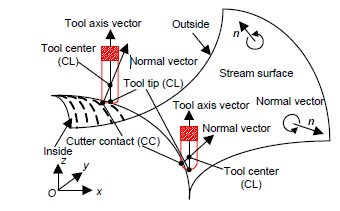Abstract: In five-axis machining, tool orientation above a blade stream surface may lead to tool collision and a decrease in workpiece rigidity. Hence, collisionless tool orientation smoothing (TOS) becomes an important issue. On the basis of a constant scallop height tool path, the triangular facets in the faces, vertices format are constructed from cutter contact (CC) using the Voronoi incremental algorithm. The cutter location (CL) points candidate set is represented by an oblique elliptic cone whose vertex lies at CC using NURBS envelope. Whether the CL point is above its CC is judged by the dot product between the normal vector and the point on triangulation nearest to the CL point. The curvatures at CC are obtained by fitting a moving least square (MLS) quadratic patch to the local neighborhood of a vertex and calculating eigenvectors and eigenvalues of the Hessian matrix .Triang-ular surface elastic energy is employed as the weight in selection from the NURBS envelope. The collision is judged by NURBS surface intersection. TOS can then be expressed by selecting a CL point for each CC point and converted into a numerical control (NC) code automatically according to the postprocessor type of the machine center. The proposed method is verified by finishing of a cryogenic turboexpander impeller of air separation equipment.
1 Introduction
The trend of advanced manufacturing is high speed, high precision, heavy duty, combined machining,and multi-axis. Five-axis numerical control(NC) machining offers the potential for efficient and accurate surface machining, but when the surface curvature changes drastically, the machining leads to many problems. For example, the collisions free tool trajectory becomes difficult and the workpiece rigidity decreases suddenly (Fard and Feng, 2010; 2011;Chen, 2011; Davim, 2012; Heinemann and Hinduja,2012).There has been very extensive research in surface machining, resulting in numerous articles presenting different methods for intersecting freeform curves and surfaces (Shan et al., 2000; Chiou, 2005;Lamikiz et al., 2005; Wang and Shan, 2005; de Lacalle et al., 2007; 2011; Bi et al., 2009; Korakianitis et al., 2012; Shen et al., 2012). Takeuchi and Watanabe(1992) generated cutter location (CL) data with collision avoidance between a workpiece and an arbitrary tool shape, based on the solid modeling technique.
Morishige et al. (1997) avoided collision by producing the direction of collision avoidance, based on the 2D configur-ation space (C-space) defined by two parameters which determine the tool attitude.Balasubramaniam et al. (2002; 2003) generated and verified globally collision-free five-axis finishing-toolpaths while also considering machine limits, tool tilt, cusp height limits, tool pitch limits, and the need to keep tool paths continuous by discretizing the part and using a haptic surface. Tournier and Duc (2002) developed a constant scallop height planning strategy to avoid tightening of the tool paths.
``````
